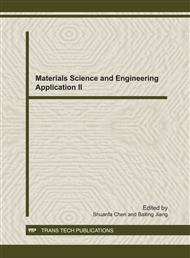[1]
M. Le-Huu, et al.: Materials Science Forum, vol. 645-648 (2010), pp.1143-1146.
Google Scholar
[2]
P. G. Neudeck, et al.: Materials Science Forum, vol. 645-648 (2010), pp.1135-1138.
Google Scholar
[3]
P. G. Neudeck, et al.: Electron Device Letters, IEEE, vol. 29 (2008), pp.456-459.
Google Scholar
[4]
Sentaurus Structure Editor User Guide (v. 2009).
Google Scholar
[5]
Sentaurus Device User Guide (v. 2009).
Google Scholar
[6]
Y. Goldberg, et al., in: Properties of Advanced Semiconductor Materials, edited by Levinshtein, Rumyantsev, and Shur, Wiley (2001).
Google Scholar
[7]
C. Persson, et al.: Journal of Applied Physics, vol. 86 (1999), pp.4419-4427.
Google Scholar
[8]
U. Lindefelt: Journal of Applied Physics, vol. 84 (1998), pp.2628-2637.
Google Scholar
[9]
Y. C. Cheng and E. A. Sullivan: Journal of Applied Physics, vol. 44 (1973), pp.3619-3625.
Google Scholar
[10]
S. Nishino, et al.: Journal of Applied Physics, vol. 61 (1987), pp.4889-4893.
Google Scholar
[11]
C. T. Sah, et al.: Surface Science, vol. 32 (1972), pp.561-575.
Google Scholar
[12]
T. Tachibana, et al.: Journal of Applied Physics, vol. 67 (1990), pp.6375-6381.
Google Scholar
[13]
T. T. Mnatsakanov, et al.: IOP Semiconductor Science and technology, vol. 17 (2002), pp.974-977.
Google Scholar
[14]
S. Nakashima and H. Harima, in: Silicon Carbide and Related Materials (Proceedings of the Sixth International Conference), Kyoto, Japan, IoP Conference Series, vol. 142, (1995), pp.269-274.
Google Scholar
[15]
W. J. Schaffer, et al., in: MRS Symposium Proceedings, Diamond, SiC and Nitride Wide Bandgap Semiconductors, San Francisco, CA, USA, vol. 339, (1994), pp.595-600.
Google Scholar
[16]
N. D. Arora, et al.: IEEE Transactions on Electron Devices, vol. 29 (1982), pp.292-295.
Google Scholar
[17]
J. C. H. Carter, et al.: Materials Science and Engineering: B, vol. 61-62 (1999), pp.1-8.
Google Scholar
[18]
W. Shockley and W. T. Read: Physical Review, vol. 87 (1952), p.835.
Google Scholar
[19]
A. Galeckas, et al.: Applied Physics Letters, vol. 71 (1997), pp.3269-3271.
Google Scholar
[20]
M. Lundstrom, in: Fundamentals of Carrier Transport, edited by Lundstrom, Cambridge University Press (2000).
Google Scholar
[21]
M. A. Capano, et al.: Journal of Electronic Materials, vol. 29 (2000), pp.210-214.
Google Scholar
[22]
C. Raynaud, et al.: Materials Science and Engineering B, vol. 29 (1995), pp.122-125.
Google Scholar
[23]
T. Troffer, et al.: Materials Science Forum, vol. 264-268 (1998), pp.557-560.
Google Scholar
[24]
T. Troffer, et al.: Journal of Applied Physics, vol. 80 (1996), pp.3739-3743.
Google Scholar
[25]
T. Troffer, et al.: Physica Status Solidi: A, vol. 162 (1997), pp.277-298.
Google Scholar
[26]
E. Danielsson, Processing and electrical characterisation of GaN/SiC Hetrojunctions and SiC bipolar transistors, Royal Institute of Technology, Stockholm, (2001).
Google Scholar
[27]
S. M. Sze and K. K. Ng, in: Physics of Semiconductor Devices, edited by Sze, Wiley (2007).
Google Scholar
[28]
R. C. Jaeger and F. H. Gaensslen: Electron Devices, IEEE Transactions on, vol. 27 (1980), pp.914-920.
Google Scholar
[29]
D. Boning and S. Nassif, Design of high-performance up circuits, MIT, Massachusetts, (2000).
Google Scholar
[30]
S. -C. Chang, et al.: Solid-State Electronics, vol. 49 (2005), p.1937-(1941).
Google Scholar


